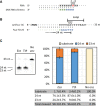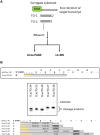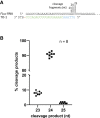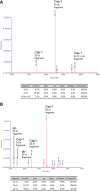RNase H-based analysis of synthetic mRNA 5' cap incorporation
- PMID: 35680168
- PMCID: PMC9297845
- DOI: 10.1261/rna.079173.122
RNase H-based analysis of synthetic mRNA 5' cap incorporation
Abstract
Advances in mRNA synthesis and lipid nanoparticles technologies have helped make mRNA therapeutics and vaccines a reality. The 5' cap structure is a crucial modification required to functionalize synthetic mRNA for efficient protein translation in vivo and evasion of cellular innate immune responses. The extent of 5' cap incorporation is one of the critical quality attributes in mRNA manufacturing. RNA cap analysis involves multiple steps: generation of predefined short fragments from the 5' end of the kilobase-long synthetic mRNA molecules using RNase H, a ribozyme or a DNAzyme, enrichment of the 5' cleavage products, and LC-MS intact mass analysis. In this paper, we describe (1) a framework to design site-specific RNA cleavage using RNase H; (2) a method to fluorescently label the RNase H cleavage fragments for more accessible readout methods such as gel electrophoresis or high-throughput capillary electrophoresis; (3) a simplified method for post-RNase H purification using desthiobiotinylated oligonucleotides and streptavidin magnetic beads followed by elution using water. By providing a design framework for RNase H-based RNA 5' cap analysis using less resource-intensive analytical methods, we hope to make RNA cap analysis more accessible to the scientific community.
Keywords: 5′ cap; LC-MS; RNA cap analysis; RNA capping; RNase H; synthetic mRNA.
© 2022 Chan et al.; Published by Cold Spring Harbor Laboratory Press for the RNA Society.
Figures










Similar articles
-
Label-free analysis of mRNA capping efficiency using RNase H probes and LC-MS.Anal Bioanal Chem. 2016 Jul;408(18):5021-30. doi: 10.1007/s00216-016-9605-x. Epub 2016 May 18. Anal Bioanal Chem. 2016. PMID: 27193635
-
Translation of stable hepadnaviral mRNA cleavage fragments induced by the action of phosphorothioate-modified antisense oligodeoxynucleotides.Nucleic Acids Res. 2005 Jan 7;33(1):114-25. doi: 10.1093/nar/gki155. Print 2005. Nucleic Acids Res. 2005. PMID: 15640448 Free PMC article.
-
In vitro transcription and capping of Gaussia luciferase mRNA followed by HeLa cell transfection.J Vis Exp. 2012 Mar 26;(61):3702. doi: 10.3791/3702. J Vis Exp. 2012. PMID: 22473375 Free PMC article.
-
Is irrelevant cleavage the price of antisense efficacy?Pharmacol Ther. 2000 Mar;85(3):231-6. doi: 10.1016/s0163-7258(99)00053-4. Pharmacol Ther. 2000. PMID: 10739877 Review.
-
mRNA capping: biological functions and applications.Nucleic Acids Res. 2016 Sep 19;44(16):7511-26. doi: 10.1093/nar/gkw551. Epub 2016 Jun 17. Nucleic Acids Res. 2016. PMID: 27317694 Free PMC article. Review.
Cited by
-
Selective Characterization of mRNA 5' End-Capping by DNA Probe-Directed Enrichment with Site-Specific Endoribonucleases.ACS Pharmacol Transl Sci. 2023 Oct 18;6(11):1692-1702. doi: 10.1021/acsptsci.3c00157. eCollection 2023 Nov 10. ACS Pharmacol Transl Sci. 2023. PMID: 37974627 Free PMC article.
-
Design and generation of mRNAs encoding conserved regions of SARS-CoV-2 ORF1ab for T cell-mediated immune activation.Future Virol. 2023 Jun;18(8):501-516. doi: 10.2217/fvl-2023-0066. Epub 2023 Jun 24. Future Virol. 2023. PMID: 38051989 Free PMC article.
-
Using nucleolytic toxins as restriction enzymes enables new RNA applications.Nucleic Acids Res. 2024 Oct 14;52(18):e90. doi: 10.1093/nar/gkae779. Nucleic Acids Res. 2024. PMID: 39271118 Free PMC article.
-
Biochemical characterization of mRNA capping enzyme from Faustovirus.RNA. 2023 Nov;29(11):1803-1817. doi: 10.1261/rna.079738.123. Epub 2023 Aug 25. RNA. 2023. PMID: 37625853 Free PMC article.
-
The Storage and In-Use Stability of mRNA Vaccines and Therapeutics: Not A Cold Case.J Pharm Sci. 2023 Feb;112(2):386-403. doi: 10.1016/j.xphs.2022.11.001. Epub 2022 Nov 16. J Pharm Sci. 2023. PMID: 36351479 Free PMC article. Review.
References
Publication types
MeSH terms
Substances
LinkOut - more resources
Full Text Sources
Other Literature Sources
Miscellaneous
